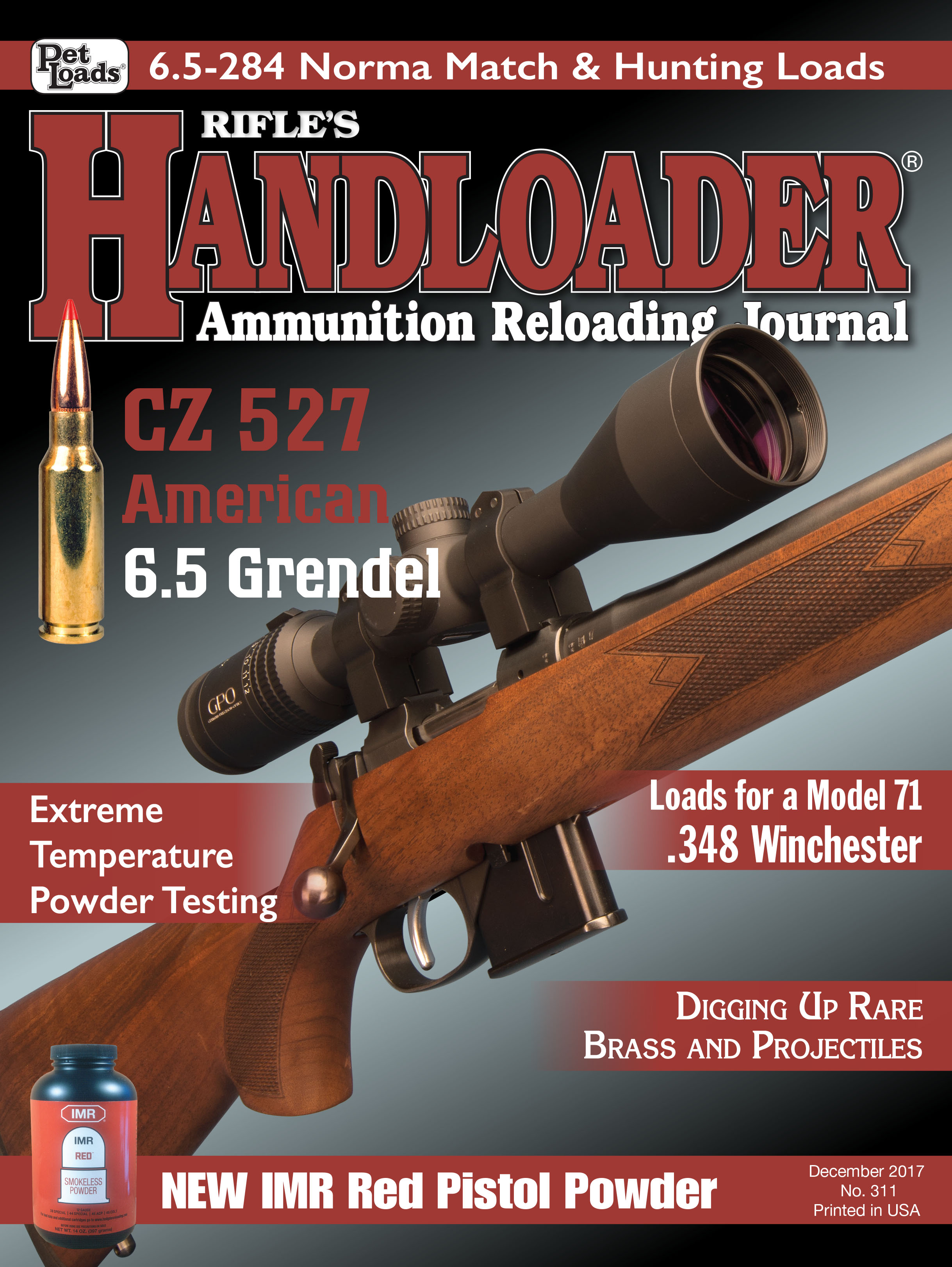Book Reviews
Lyman 50th Edition Reloading Handbook
column By: R.H. VanDenburg, Jr. | December, 17
The name Lyman has been around since 1878, when the Lyman Gun Sight Corporation was founded. The association of Lyman with reloading began in 1925, when Lyman purchased the Ideal Products Reloading Tool Company. Ideal, founded in 1884, began offering catalogs of its products immediately and soon, probably 1888, issued its first Ideal Handbook. These early handbooks lacked our modern, sophisticated testing results and real velocity and pressure information. On the other hand, they were, and are, a delight to read, as users of the company’s products often passed on stories of their successes.
When Lyman purchased Ideal, it continued production of the handbooks, first under the Ideal name, then identifying Lyman as the publisher, and finally simply as the Lyman Reloading Handbook. Last year, Lyman published the 50th edition.
The 50th edition is much like the 49th that was published in 2008. It is 8.5x11 inches with a softcover, but a hardcover edition is
.jpg)
Much of this growth comes from the inclusion of new cartridges. By my count, these include 15 rifle cartridges from .17 Hornet to .50 Beowulf, and two handgun cartridges, the .32 S&W and .327 Federal. The powder lineup has changed as well. I counted 10 additions, including the now-discontinued IMR-4007ssc. Four powders were dropped: A-8700, HS-7, H-4227 and H-870. There are also changes in the bullets that reflect changes in the industry. Much of this has to do with timing. Between beginning to assemble such a book and publishing it, things change. New cartridges and powders are added while others are discontinued. The .26 and .28 Nosler cartridges are covered, for example, but the .30 Nosler is not. There have been several powders that were discontinued but are still included this time around. That’s not a bad thing, as many handloaders have supplies enough to last a while.
The book is divided into sections and chapters. The first three sections are carryovers from previous editions. Section 1 is “An Introduction to Reloading” and includes chapters on “Why Reload” and “Getting Started Safely.” Section 2 is “The Basics of Reloading” with chapters on “Reloading Rifle Cartridges” and “Reloading Handgun Cartridges.” Section 3, “The Components of Reloading,” includes five chapters addressing cases, primers, powders, jacketed bullets and cast bullets. These first three sections are all old hat to many readers, I suppose, but I still find them worth reading even today.
Section 4 is “Specialty Articles.” It begins with a fascinating piece, “The History of Modern Lyman Handbooks,” written by the editors spanning 1965 to the present. First was the late Ed Matunas, then Ken Ramage and current editor Tom Griffin. Actually, Griffin has been included in every Lyman book in some capacity since 1981. As a reloading manual fan, this may be my favorite part of the book.
Next is a fine piece, “Advanced Case Preparation Techniques,” by our own John Haviland. Following this is a very interesting article, “What is a Ballistic Coefficient and How Do You Use It?” by Dave Emary, Hornady’s senior ballistician, and includes a section on sectional density by Lane Pearce. Wrapping up this section is a review of the new Lyman Borecam Digital Borescope, “Barrels: Looking Into the Unknown,” by Ryan Newport, Associate Professor of Gunsmithing at Trinidad State. It is well done, and interesting to me, it takes a slightly different tack than I took before in reviewing the Borecam for this magazine.
Section 5 is the good stuff: the load data. The information on each cartridge begins with a dimensional drawing and a picture of a loaded round. Following this is text describing the cartridge and sections on test components and test specifications that include the firearm used, barrel length, twist and groove diameter. Data is presented by jacketed bullet, from lightest to heaviest, with a picture of the bullet, its type, cartridge overall length, ballistic coefficient and sectional density. The actual load data is presented by powder, from fastest to slowest, and includes the powder’s name, suggested starting load in grains with corresponding velocity in feet per second (fps) and pressure in psi. These are followed by the maximum load in grains and its velocity and pressure. In some of the older data, which was not reshot from previous editions, pressure is given in CUP. Following the jacketed bullet data for many cartridges is data in the same format for cast bullets. Maximum loads appear in shaded panels. Potentially most accurate loads appear in bold type. Notes indicate when more than one brand of case and primer was used in the development of the data.
Pages are shaded on their edges for about 2 inches to identify ranges of calibers. For example, the first range is .17 to .22 caliber, the second is .24 to .270 caliber, the third is .28 caliber and so on. Following the rifle section is the handgun section laid out in the same manner, although there is a separate section for T/C Contender and Encore data.
Ending the book is the Reference section with four appendices: Bullet Type Abbreviations; Useful Formulas for Reloaders; Shellholder charts for Lyman, Hornady, RCBS and Redding shellholders and a relative burn rate chart.
I really like the Lyman 50th Edition Reloading Handbook. Bullet and powder selections are generous across the board, not restricted to a single manufacturer, and there is cast bullet data to boot. It is heartwarming to see an institution older than any of us continue on in such fine form – and it is the 50th edition. In our small corner of the world, that’s a big deal. MSRP: $30.00. For more information and to order a copy, visit www.lymanproducts.com.


